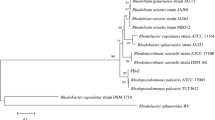Abstract
Rhodopseudomonas palustris TN1 was isolated from Songkhla Lake, Thailand. It phototrophically generates H2 from the predominant volatile fatty acids (VFAs) produced from microbial dark-fermentations of palm oil milling effluent; yields from 20 mM butyrate, acetate and propionate were 4.7, 2.5, and 1.7 mol H2 mol VFA−1 with light efficiencies of 1.8, 1, and 0.2%, respectively. Optimum conditions were pH 7 and 3000 lux, although production was reduced by only 33% at 1000 lux. CO2 evolution never exceeded 9 mmol mol VFA−1.


Similar content being viewed by others
References
Barbosa MJ, Rocha JMS, Tramper J et al (2001) Acetate as a carbon source for hydrogen production by photosynthetic bacteria. J Biotechnol 85:25–33
Dunn S (2002) Hydrogen futures: toward a sustainable energy system. Int J Hydrogen Energy 27:235–264
Kaplan S (1978) Control and kinetics of photosynthetic membrane development. In: Clayton RK, Sistrom WR (eds) The photosynthetic bacteria. Plenum Press, New York, pp 809–839
Khanal SK, Chen WHW-H, Li L et al (2004) Biological hydrogen production: effects of pH and intermediate products. Int J Hydrogen Energy 29:1123–1131
Korber H, Kwintkiewicz C, Maravic D et al (2007). Best practice guidelines for eco-efficiency in palm oil industry. Department of Alternative Energy Development and Efficiency (DEDE) and GTZ under Energy & Eco-Efficiency in Agro-Industry (E3 Agro-Project). Ministry of Energy, Thailand, p 40
Levin DB, Zhu H, Beland M et al (2007) Potential for hydrogen and methane production from biomass residues in Canada. Bioresour Technol 98:654–660
O-Thong S, Prasertsan P, Intrasungkha N et al (2008a) Optimization of simultaneous thermophilic fermentative hydrogen production and COD reduction from palm oil mill effluent by Thermoanaerobacterium-rich sludge. Int J Hydrogen Energy 33:1221–1231
O-Thong S, Prasertsan P, Karakashev D et al (2008b) Thermophilic fermentative hydrogen production by the newly isolated Thermoanaerobacterium thermosaccharolyticum PSU-2. Int J Hydrogen Energy 33:1204–1214
Prasertsan P, Choorit W, Suwanno S (1993) Optimization for growth of Rhodocyclus gelatinosus in seafood processing effluents. World J Microbiol Biotechnol 9:593–596
Shi XY, Yu HQ (2006) Conversion of individual and mixed volatile fatty acids to hydrogen by Rhodopseudomonas capsulata. Int Biodeter Biodegr 58:82–88
Suwansaard M, Choorit W, Zeilstra-Ryalls JH et al (2009) Isolation of anoxygenic photosynthetic bacteria from Songkhla Lake for use in a two-staged biohydrogen production process from palm oil mill effluent. Int J Hydrogen Energy 34:7523–7529
Acknowledgments
This work was financially supported by the Royal Golden Jubilee Ph.D. Program of the Thailand Research Fund, the Joint Graduate School of Energy and Environment of King Mongkut’s University of Technology Thonburi, Thailand, the Graduate School of Prince of Songkla University, Thailand, the Center for Environmental Microbiology established through the auspices of the Research Enhancement Initiative at Bowling Green State University, USA, and the National Science Foundation, USA (MCB-0921449; American Recovery and Reinvestment Act of 2009).
Author information
Authors and Affiliations
Corresponding author
Additional information
Purpose of work
To investigate the potential of photosynthetic bacteria to ameliorate negative environmental impacts of palm oil milling in southern Thailand by using the fermentatively pretreated wastewaters as a medium for their growth and H2 production.
Electronic supplementary material
Below is the link to the electronic supplementary material.
Rights and permissions
About this article
Cite this article
Suwansaard, M., Choorit, W., Zeilstra-Ryalls, J.H. et al. Phototropic H2 production by a newly isolated strain of Rhodopseudomonas palustris . Biotechnol Lett 32, 1667–1671 (2010). https://doi.org/10.1007/s10529-010-0345-2
Received:
Accepted:
Published:
Issue Date:
DOI: https://doi.org/10.1007/s10529-010-0345-2




